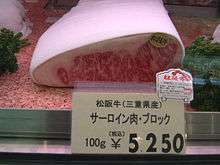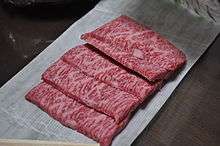Matsusaka beef
Matsusaka beef (松阪牛, Matsusaka-ushi, Matsusaka-gyū also "Matsuzaka beef") is the meat of Japanese Black cattle reared under strict conditions in the Matsusaka region of Mie in Japan. It has a high fat-to-meat ratio. Within Japan, it is one of the three Sandai Wagyū, the "three big beefs"; the others are Kobe beef and Ōmi beef or Yonezawa beef. About 2500 cows are slaughtered for Matsusaka beef each year; the meat commands high prices.[1]
 Matsusaka loin for sale in Tokyo | |
| Type | Beef |
|---|---|
| Place of origin | Japan |
History


Before the 19th century, beef was not typically a part of the average Japanese diet.[2] Farmers in the Mie Prefecture would raise smaller and more muscular, female cows to do agricultural work.[2] When westerners introduced them to eating beef, farmers began to raise the cows to have traits that were more favorable for human consumption.[2] The "National Beef Exposition" awarded Matsusaka with the medal of high honor in 1938.[2] The award helped make Matsusaka more well known.[2] The beef became famous for its marbling, rich flavor, and tenderness.[3]
Original standards
The cows take roughly three years to mature.[2] In order for the meat to be sold under the Matsusaka name, it must meet strict standards.[2] Only virgin female cows can be sold as Matsusaka beef and all calves must be of a breed registered by the Matsusaka Beef Management System.[2] Most of the meat is sold through stores owned by the Matsusaka Beef Cattle Association.[4] To prevent cheap meat from being sold under the Matsusaka name, all authentic stores have an "Association Member's Certificate".[4] The Mie Prefecture Matsusaka Shokuniku Kosha public corporation implemented a system for tracking the cows to ensure authenticity.[4] All cattle are given a 10-digit ID.[4] The date of birth, location of birth, date it was slaughtered, shipping information, and the bloodline of each cow can be found by entering the ID on a website.[4]
Cooking
While Matsusaka beef can be eaten as a steak, there are more traditional methods of cooking the meat.[5] Shabu-shabu is prepared with very thin slices of meat which are quickly dipped in a kelp broth and then eaten.[5] Sukiyaki is a method that involves simmering thin slices of meat in a pot with a sauce of sugar, sake and soy sauce.[5] After the meat has been cooked, it is removed from the pot, dipped in a raw egg and eaten.[5] The melting in one's mouth sensation comes from the unsaturated fatty acids in the beef.[4]
References
- Strom, Stephanie (18 July 2001). "In Japan, A Steak Secret To Rival Kobe". The New York Times. ISSN 0362-4331. Retrieved 13 February 2017.
- Matsusaka Beef. JapanBrand. Japan National Tourism Organization.Accessed January 2018.
- "Matsusaka Beef - Mie - Japan Travel - Tourism Guide, Japan Map and Trip Planner". JapanTravel. Retrieved 29 January 2017.
- [editorial] (June 2016). Matsusaka Beef, the Ultimate Wagyu: a Visually-Arresting and Delicious Work of Art. Japan Quality Review.
- Brandi Goode, for. "Ultimate Japan Wagyu beef guide". CNN. Retrieved 3 February 2017.
Further reading
- Stephanie Strom. "In Japan, A Steak Secret To Rival Kobe". The New York Times, 18 July 2001. Accessed 16 June 2008.